In September, protesters in the Philippines began taking to the streets, accusing the government of misusing billions of dollars allocated for flood control.
The Southeast Asian island nation is one of the most climate-vulnerable countries in the world and has implemented nearly 10,000 flood control projects in the past few years.
In some ways, the protests echoed concerns expressed by demonstrators and representatives of affected countries every year at United Nations climate summits: that climate funds designed to serve the public good should reach the people most affected by climate disasters.
Why did we write this
Countries around the world are spending trillions of dollars to solve climate problems. Money doesn't always reach the places that need it most, meaning some people are left vulnerable to increasingly severe storms.
As world leaders gather for this year's COP30 in Belem, Brazil, from November 10 to 21, public anger in the Philippines is raising larger questions about the global issue: who pays for climate change response and sustainability, who benefits and how much money is siphoned off due to poor governance or corruption.
What were the protests?
Previous demonstrations at COP, the annual meeting of governments belonging to the United Nations Framework Convention on Climate Change (UNFCCC), called on rich countries to compensate developing countries that bear the brunt of emissions they did not cause.
There is opposition to climate change spending: Research from Stanford University shows that the number of countries with at least one “climate change organization”—such as a think tank, research institute or foundation—has more than doubled over the past 35 years. The report's author says economic interests in the energy and agricultural sectors are helping shape the movement.
However, countries around the world have committed to spending trillions of dollars to mitigate climate change.
In the Philippines, tens of thousands of people demonstrated during the week of Sept. 21, sparked by a Treasury Department report that corruption related to flood relief projects led to losses of up to PHP118.5 billion ($2 billion) in 2023-2025. Lawmakers and officials allegedly pocketed money in exchange for contracts while hundreds of projects designed to protect the country from flooding never materialized.
Jefferson Chua, a campaigner for Greenpeace Southeast Asia, says many in the Philippines suspected corruption even before the finance department's report.
“Sometimes there are even jokes around here that when money goes into these kinds of public projects, we all know that a lot of that money goes into the pockets of these politicians,” Mr Chua says.
He notes a common saying in the Philippines: “The Filipino spirit is waterproof.” But according to the Intergovernmental Panel on Climate Change, there is evidence of more intense and more frequent storms in Southeast Asia. A tropical storm in late October killed seven people and forced more than 22,000 people to evacuate.
Most protests ended soon after they began when a typhoon, a weather event that causes significant flooding, hit the country on September 22. More protests were expected, The Philippine Star reported.
How much money is allocated to combat climate change?
This is tricky, in part because it can be difficult to know what counts as climate finance.
The UNFCCC definition is nearly 100 words long and covers everything from reducing emissions to “increasing the resilience of human and environmental systems” and achieving the Paris Agreement's goal of reducing emissions by 43% globally by 2030.
Some 55 countries and jurisdictions say they have or are developing climate finance tracking systems. But it can still be difficult to understand what climate finance is and what is not.
For example, grants that help build and maintain public transportation may not be explicitly identified as such, although they may help reduce greenhouse gas emissions from automobiles.
A recent UNFCCC report said global spending reached an average of $1.3 trillion in 2021-22, the most recent data available. This includes money directed towards areas such as sustainable transport, clean energy systems, and buildings and infrastructure.
This figure includes the newly created Loss and Damage Response Fund, which is headquartered in the Philippines. The COP resolution created it to help low-income countries, those most vulnerable and affected by climate change, pay for the damage caused by climate-related disasters. Twenty-seven countries pledged $768 million. Payments to affected countries have not begun.
How much of climate finance is being misused?
Bryce Boehmer, director of climate and environment at Transparency International, helped develop the Climate and Corruption Atlas. He says it can be difficult to distinguish mismanagement from corruption.
“Even if it is indeed corruption, it is very difficult to prove,” Mr. Böhmer says. “Because it’s more about the intent behind the mismanagement.”
Cases of climate corruption extend beyond the Philippines. In 2021, the energy company agreed to a $230 million fine as part of a settlement with federal prosecutors who accused the company of a bribery scheme to advance legislation that included a $1 billion bailout for two power plants in Ohio, NPR reported. In Germany, Germany's deputy environment minister was fired in 2023 after he named the best man at his wedding as chairman of the board of the national energy agency, according to Reuters.
Mr. Boehmer says a major obstacle to documenting corruption is gaining access to information in countries where people raising concerns fear government retaliation. He says it's important to have complaint and advocacy mechanisms in place for those who raise questions.
“For example, the environmentalists and whistleblowers who bring these cases to our attention are doing work that benefits us all,” he says. “And they are usually prosecuted and punished, when those who commit corrupt acts should be held accountable.”
In the Philippines, President Ferdinand Marcos Jr. created an independent commission to investigate the disappearance of funds. The country's interior minister estimates that about 200 people could be charged in an anti-corruption court targeting government officials.








